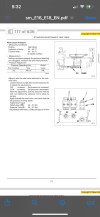Don't confuse standby with work. A variable displacement pump produces standby pressure at idle with no requests made. At the same time, either through stand alone vane pump or pressure reducing valve on main feed, you have pilot pressure built up. The pilot oil feeds your joysticks with approximately 450-475 psi. The joysticks, based on your physical input, send a proportional oil pressure to move the spool to exercise a function. When the spool shifts off neutral, it allows some of the "main" oil to leak by in what's known as load sensing. The load sensing line carries that pressure to the pump which changes the displacement, commonly referred to as "stroking" the pump. Increased rpm, combined with increased volume give you work flow. As you reach the end of travel or a pressure which the pump can't support, the pump destrokes either by electronic pump regulators or simple flow compensators which effectively throttle the pump to avoid damage.
This is kinda the "cliff notes" version of how it works if, IF you have hydraulic pilot control. If you have cable and clevis, it'll be completely different. Good luck, hope this helps


